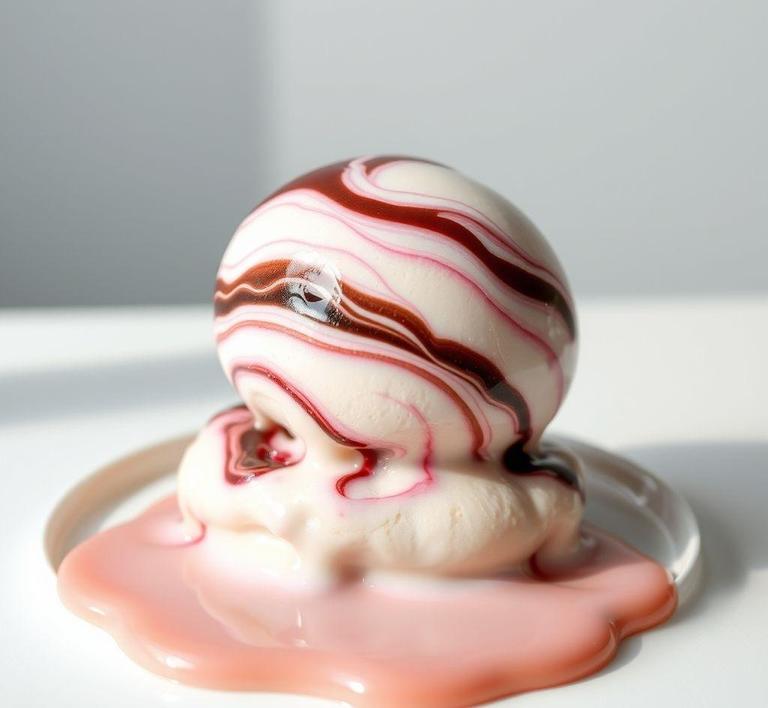We’ve all been there-you’re enjoying a pint of non-dairy ice cream, only to realize it’s melted into a sad puddle. Whether it’s from a power outage, leaving it out too long, or an accidental mishap, you might wonder if it’s even worth trying to refreeze it. The good news? You can actually save that melted non-dairy ice cream with a few simple tricks. In this guide, we’ll walk you through the best steps to refreeze your dessert without sacrificing its flavor or texture. So, grab that tub and let’s get to work on bringing it back to life!
Can You Refreeze Melted Non-dairy Ice Cream?

Refreezing melted non-dairy ice cream is a question of both food safety and product quality. To begin with, yes-you can refreeze melted non-dairy ice cream, but whether you should depends on a few critical factors.
Unlike traditional dairy-based ice cream, non-dairy varieties are crafted from a wide range of plant-based ingredients-coconut milk, almond milk, oat milk, soy, cashew, and even pea protein. These bases tend to behave a bit differently under freezing and thawing conditions. While they don’t harbor the same foodborne bacteria risks that raw dairy might (like Listeria), they’re not entirely exempt from safety concerns. If the melted non-dairy ice cream has been sitting out at room temperature for more than two hours-or one hour if the ambient temperature exceeds 90°F (32°C)-then harmful bacteria, including mold or yeast, can still flourish, especially in products with added sugars or fruit-based swirls.
So, if your non-dairy pint melted slightly on the ride home from the store or softened in a bowl before being returned to the freezer quickly, it’s generally safe to refreeze. However, if the ice cream was fully liquefied and left out for a long time, err on the side of caution and discard it. Safety comes first.
How To Refreeze Melted Non-dairy Ice Cream?
If you’re confident the ice cream has not been compromised by time or temperature, here’s how to refreeze it properly to retain as much of the original quality as possible:
-
Assess Consistency and Contents:
- Is the entire pint melted, or only partially softened?
- Are there chunks (cookies, fruit, nuts) that might separate or become mushy during refreezing?
- Is the flavor or base particularly delicate (like avocado or banana-based ice cream), which may not refreeze as cleanly?
-
Stir and Smooth:
- Before placing it back in the freezer, give the softened ice cream a vigorous stir to reincorporate any separated ingredients. This prevents icy layers from forming and helps restore its creamy texture.
-
Use an Airtight Container:
- If the original container is damaged or not tightly sealable, transfer the mixture to a clean, airtight freezer-safe container. Exposure to air will accelerate freezer burn and worsen texture.
-
Freeze Quickly:
- Place the container at the back of your freezer where the temperature is most stable and coldest. Rapid freezing reduces the size of ice crystals, which helps preserve texture.
-
Label and Date:
- Label your container with the refreeze date. For best quality, consume within 1-2 weeks, as the second freeze may further degrade texture and flavor over time.
Quality Impact
Refreezing non-dairy ice cream can have noticeable consequences on its texture, flavor, and overall appeal. Plant-based bases, while increasingly refined and creamy, are generally more susceptible to changes in consistency than traditional dairy ice cream when subjected to a freeze-thaw-refreeze cycle.
Here’s what you might experience:
-
Texture Degradation:
- Expect iciness or graininess due to the formation of larger ice crystals during the refreezing process. Many non-dairy formulations rely on emulsifiers and stabilizers to maintain creaminess, but once melted and refrozen, those structures can collapse.
-
Flavor Muting or Alteration:
- Repeated freezing can dull the vibrant notes of natural ingredients like cocoa, vanilla, or fruit. Some ingredients may oxidize slightly or develop off-flavors over time.
-
Separation of Ingredients:
- If the ice cream includes swirls, sauces, or mix-ins (such as caramel or chocolate fudge), these may behave differently upon refreezing-becoming overly firm, sticky, or even crumbly, disrupting the intended balance of textures.
-
Loss of Airiness:
- Many ice creams, even non-dairy ones, are churned with air during manufacturing to give them a light, scoopable structure. Once melted, that air is lost, and refreezing without re-churning results in a denser, often less pleasant mouthfeel.
In short, while the refrozen product may still be edible and safe, it’s unlikely to recapture the smooth, luscious creaminess you enjoyed when it was freshly opened.
Refreezing melted non-dairy ice cream is a nuanced decision that balances safety and quality. If it has only softened and hasn’t been left out too long, you can refreeze it with relatively low risk. However, you should expect some compromise in texture and taste. The freeze-thaw-refreeze cycle is especially unkind to the delicate structures of plant-based frozen desserts, which rely heavily on precise emulsification and aeration for their creamy consistency.
Whenever possible, portion only what you plan to eat, and return the container to the freezer promptly. If your non-dairy pint takes an unfortunate detour through melting, act quickly and smartly. Stir, seal, and refreeze-but temper your expectations. That once-silky spoonful may now come with a few ice crystals and a bit less charm.
Is It Safe To Refreeze Melted Non-dairy Ice Cream?
Refreezing melted non-dairy ice cream is not a straightforward yes or no-it depends heavily on how long the ice cream has been melted and at what temperature.
Non-dairy ice creams are typically made from plant-based milks like almond, oat, soy, coconut, or cashew. These bases, combined with stabilizers and emulsifiers, create a creamy texture similar to dairy-based ice cream. However, these ingredients don’t behave the same way when subjected to temperature fluctuations.
If non-dairy ice cream has only partially melted and has remained at or below 40°F (4°C) for under two hours (think of it softening on the drive home from the grocery store), it’s generally safe to refreeze. The texture may degrade slightly-expect a grainier or icier result-but there’s minimal food safety risk in this scenario.
However, if the ice cream has fully melted and sat out at room temperature for more than two hours (or one hour if the temperature exceeds 90°F/32°C), harmful bacteria may have proliferated. Even though non-dairy ice cream doesn’t contain lactose or animal proteins, it often includes sugars, starches, and fats that provide a fertile environment for bacterial growth. Refreezing in this case would lock in potential pathogens, posing a health risk.
Bottom line: it’s safe to refreeze if the melt was minimal and brief-but avoid refreezing if it was prolonged or occurred at unsafe temperatures.
Signs That Melted Non-dairy Ice Cream Should Not Be Refrozen
Refreezing non-dairy ice cream can sometimes do more harm than good. Before you pop that pint back in the freezer, look for these telltale signs that it’s better off discarded:
- Sour or Off Smell: Even plant-based ingredients can spoil. If your ice cream smells fermented, tangy, or just “off”, it’s likely undergone bacterial changes. Don’t risk it.
- Slimy or Separated Texture: Once thawed, many non-dairy bases-especially coconut or soy-can separate into water and fat. If the mixture looks curdled or has an oily film, it’s best not to refreeze.
- Change in Color: Discoloration or darkening (especially around the edges) can indicate oxidation or microbial activity.
- Bubbling or Unusual Consistency: If you notice unexpected fizzing or bubbling, this can be a sign of fermentation-a clear warning to toss it.
- Presence of Ice Crystals After Refreezing: This can indicate repeated thawing and freezing cycles. While not inherently dangerous, it’s a signal that the quality has degraded significantly, and it may not be safe depending on prior temperature exposure.
Common Refreezing Mistakes
Mistakes in handling melted non-dairy ice cream are surprisingly common. Here are the most frequent (and avoidable!) errors people make:
- Refreezing After Hours at Room Temperature: The most dangerous mistake. Warm, melted ice cream is a breeding ground for bacteria. Freezing doesn’t kill bacteria-it merely puts them on pause.
- Using the Microwave to Soften and Then Refreezing: Microwaving alters the emulsion and causes parts of the ice cream to heat unevenly. Once thawed by microwave, the structural integrity of the dessert is lost.
- Refreezing Multiple Times: Repeated thawing and freezing causes textural breakdown, flavor loss, and bacterial risks to multiply. Each cycle further compromises safety and quality.
- Refreezing in a Non-Airtight Container: Exposure to freezer air causes “freezer burn”, ice crystal formation, and flavor contamination from nearby frozen foods. It also hastens degradation.
- Not Labeling the Ice Cream After Refreezing: Without noting when it was last thawed, it’s easy to forget how long it has been sitting, increasing the risk of unknowingly eating spoiled dessert.
💡 Tips And Tricks For Safe Refreezing (and Enjoyment!)
If you find yourself needing to salvage slightly softened non-dairy ice cream, here’s how to do it the right way:
- Freeze Sooner, Not Later: The fresher and less melted the product, the better the refreezing results. Get it back into a sub-zero environment as soon as possible.
- Stir Before Refreezing: If it has begun to melt but not entirely, give it a good stir to evenly distribute any separated ingredients. This can help minimize textural weirdness later.
- Use Smaller Portions: Divide the softened ice cream into smaller containers. These freeze faster, reducing the chance of bacteria growing during the re-freeze process.
- Add a New Twist: If the texture is no longer ideal, repurpose it! Blend it into a smoothie, mix it into a shake, or bake it into a plant-based dessert. It might not be scoop-worthy, but it can still be delicious.
- Use Freezer-Safe, Airtight Containers: Transfer to well-sealed containers to prevent freezer burn and flavor migration. Bonus points for labeling with the date of refreezing!
Conclusion
While it might seem like a small decision, whether or not to refreeze melted non-dairy ice cream carries implications for both food safety and enjoyment. Unlike traditional dairy, plant-based ice creams may lack certain preservatives and behave differently when exposed to heat or fluctuating conditions. Always assess how long the ice cream has been melted, inspect it thoroughly for any signs of spoilage, and follow best practices if you choose to refreeze.
When in doubt, it’s better to play it safe-no dessert is worth a foodborne illness. But with a little awareness and quick action, you can often salvage your sweet, creamy plant-based treat and enjoy it safely later on.
After all, every scoop counts.


